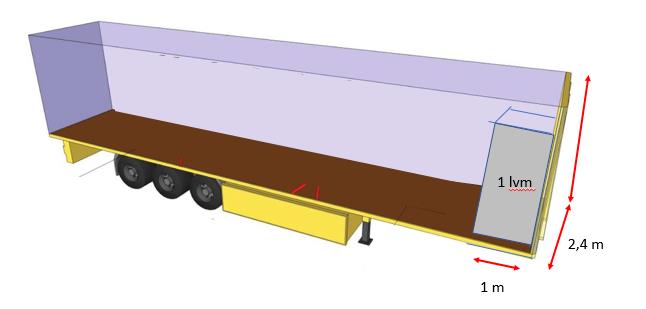The chargeable weight takes into account the actual weight of the shipment, its cubic volume, and the actual space used on a pallet or in the loading area. The calculation also considers how the shipment is secured and its placement in the cargo space in accordance with traffic safety requirements.
Volumetric weight = 333 kg / m³
Measure the outer dimensions of the package (length × width × height) and multiply the result by 333.

Pallet weight
- FIN pallet: dimensions 1.2 m × 1.0 m, weight 925 kg = 0.5 loading metres (lm), empty pallet weight 60 kg
- EUR pallet: dimensions 1.2 m × 0.8 m, weight 740 kg = 0.4 lm, empty pallet weight 50 kg
- Half pallet: dimensions 0.8 m × 0.6 m, weight 370 kg = 0.2 lm, empty pallet weight 20 kg
- Roll cage: dimensions 0.68 m × 0.8 m, max weight 420 kg = 0.22 lm = 1.26 m³
Loading metre weight = 1850 kg / loading metre (length × width / 2.4 m)
A loading metre refers to one metre of pallet space across the full width and height of the loading area. Loading metres are always charged if it is not possible to load on top of or beneath the shipment.

Long items and item bundles
A long item surcharge will be applied based on the length of the item being transported, according to the price list:
- item length 2.4 m – 3.9 m
- item length 4.0 m – 5.9 m
- item length 6.0 m – 9.9 m
- item length 10 m and over
The sender must always state the item’s length on the consignment note or when placing the order.
Overloading on top of long items may be allowed in the following cases:
- The shipment’s units can be safely stacked up to 2.4 m in height (stable, durable and in good condition)
- The height of the unit or pallet must not exceed 1.2 m and must be suitable for mechanical handling
- The unit weighs no more than half of the rated chargeable weight of a pallet space
- The item is not classified as a dangerous good (VAK-classified items may not be stacked)
The carrier always reserves the right to adjust the chargeable weight to reflect the actual shipment.
